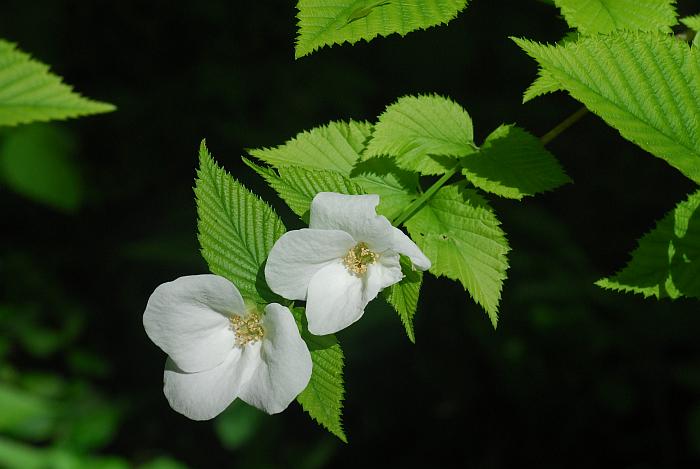Rhodotypos scandens (Thunb.) Makino
Jet Bead

Introduced
CC = *
CW = 5
MOC = 4
© SRTurner
Rhodotypos scandens (Thunb.) MakinoJet Bead | |
 |
Introduced CC = * CW = 5 MOC = 4 |
© SRTurner |
|
Family - Rosaceae Habit - Shrub, to 2 m. Stems - Arched, slender, branched. Twigs green becoming brown, glabrous. Winter buds small with several overlapping scales.
Leaves - Opposite, petiolate, simple, stipulate. Stipules 2-4 mm, linear, hairy, early deciduous. Petioles to 1 cm, short-hairy. Blades to 8 cm, ovate, rounded at base, sharply pointed, the margins sharply, irregularly, and doubly toothed, the upper surface green, sparsely pubescent, sometimes somewhat shiny, with the main veins impressed, the undersurface slightly lighter green, sparsely to moderately hairy, with raised veins.
Inflorescences - Solitary and terminal. Flowers on stalks 6-13 mm long, subtended by 4 bractlets, these alternating with the sepals, 2.5-5.0 mm long, linear to narrowly lanceolate, usually shed as the fruits mature. Flowers - Perigynous, the hypanthia saucer-shaped, with a prominent, ridgelike, irregularly 4-lobed disc just inside its rim. Sepals 4, 8-16 mm long, ovate, sharply pointed, the margins with numerous, irregular, sharp, slender teeth, short-hairy, at least toward the tips, persistent at fruiting. Petals 4, 17-25 mm long, broadly obovate to nearly circular, white. Stamens numerous, the filaments often grouped into more or less 4 clusters, white, the anthers yellow. Pistils usually 4 per flower, each with 1 carpel, more or less covered by the hypanthial disc at flowering. Ovaries superior, each with 1 locule, each with 2 ovules. Styles 1 per pistil, slender, the stigma capitate.
Fruits - 1-4, aggregated, drupelike (the inner layer thin and hard, the middle layer dry, papery, the outer layer thin, hard), 7-9 mm in the longest dimension, asymmetrically broadly obovoid to broadly ellipsoid, the outer surface glabrous, smooth, black or brownish black, shiny. Flowering - April - June. Habitat - Mesic forest understory. Origin - Native to Asia. Lookalikes - Broadly, species of Philadelphus. Other info. - This shrub, striking and easily identified when in flower, is uncommon in Missouri. It is an unusual representative of the rose family in having simple, opposite leaves. There are indications that it can become invasive in some woodlands; however at present it is only sparsely distributed in North America. Photographs taken near St. Albans, Franklin County, MO, 4-27-2015 (SRTurner). |